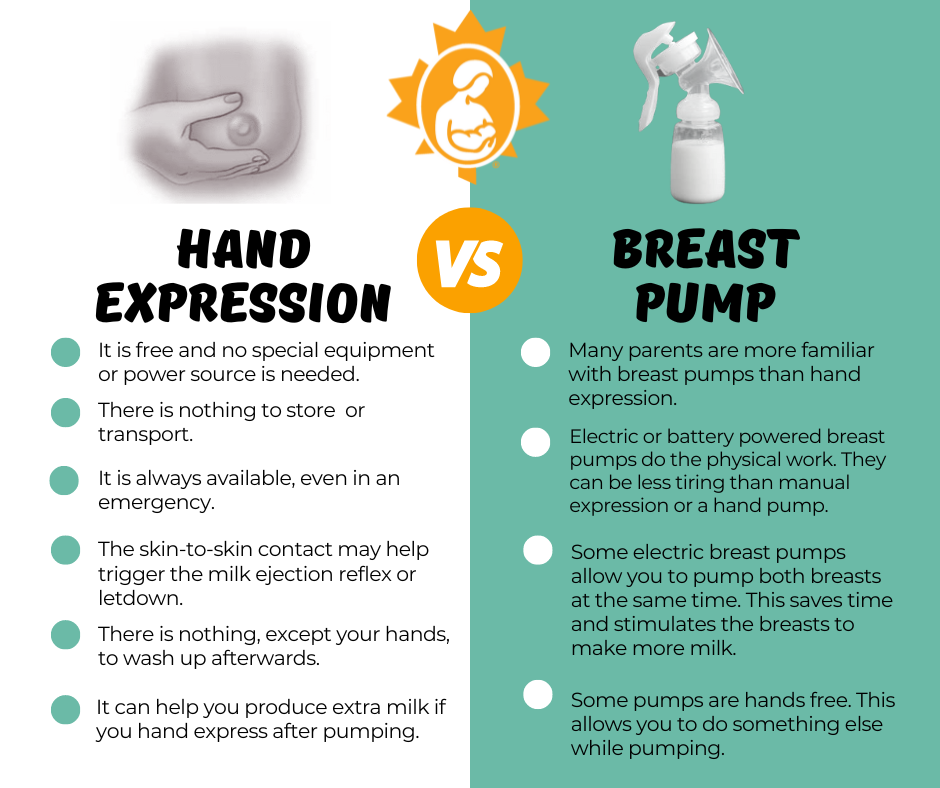
As you are preparing for your baby’s arrival, you may be wondering whether or not you need a breast pump.
When Milk Expression Is Needed
Many women breastfeed without ever pumping or expressing their milk by hand. If you pump or express more milk than your baby needs, you are at increased risk of developing mastitis (inflammation of the milk-producing ducts). Mastitis is often linked to the use of electric pumps. However, there are some situations in which it is helpful to be able to remove your milk other than by feeding your baby at the breast.
Reasons to express milk (either by hand or with a pump)
- Your baby is unable to feed directly at the breast.
-Your baby is too sleepy to feed.
-Your baby is premature or medically unable to feed yet.
-Your baby has an oral restriction such as tongue-tie.
-Your baby is unable to latch yet. - Your baby is not yet able to empty your breasts fully to get enough milk to grow.
- You need to increase your milk production. Expressing milk after feeding your baby can stimulate your body to increase milk production over time.
- You and your baby are separated, either occasionally or regularly. You can express your milk so that it can be fed by someone else.
- Your breasts are engorged and painful. Your baby is full or not with you.
- You don’t feel comfortable putting your baby to breast and want your baby to have your milk.
The reason for expressing your milk impacts your decision on whether or not to use hand expression or a breast pump. A nursing parent who is separated from their hospitalized baby has very different needs than someone who may need to occasionally miss a feeding.
Hand Expression
Advantages
- It is free and no special equipment or power source is needed.
- There is nothing to store or transport.
- It is always available, even in an emergency.
- The skin-to-skin contact may help trigger the milk ejection reflex or letdown. Many mothers say it feels more “natural”. Pumps can feel like machines.
- There is nothing, except your hands, to wash up afterwards.
- It can help you produce extra milk if you hand express after pumping.
Drawbacks
- There is a learning curve.
- It involves physical effort that may become tiring on the hands and wrists.
- It may take more time to manually express both breasts. With a double electric breast pump, you can pump both sides at the same time.
- Hand expression alone may not be sufficient to establish a milk supply for a baby not yet breastfeeding.
Breast Pumps
There are many different kinds of breast pumps:
- Hand pumps
- Battery-operated pumps
- Electric pumps
- Single pumps and double pumps
Advantages
- Many parents are more familiar with breast pumps than hand expression. Some are uncomfortable touching their own breasts.
- Electric or battery powered breast pumps do the physical work. They can be less tiring than manual expression or a hand pump.
- Some electric breast pumps allow you to pump both breasts at the same time. This saves time and stimulates the breasts to make more milk.
- Some pumps are hands free. This allows you to do something else while pumping.
Drawbacks
- It may be difficult to find the right size flange for your breasts. This depends on the size and shape of your nipples and breasts. You’ll want a flange that allows the nipple to slightly touch the sides of the tunnel when it is drawn in. The right size flange removes the most milk. Pumping should not hurt.
- There is a learning curve to mastering a breast pump.
- The brand of pump you purchase may not be the best pump for your body.
- The most effective breast pumps are hospital grade electric models which can be very costly to rent or buy.
- Pump parts can break, get lost, or malfunction. Then the pump is not functional. Manufacturers usually recommend that some parts be replaced every few months. See the breast pump manual for more information.
- When pumping in public places, the pump’s sound can draw unwanted attention.
- You will need access to a place where you can wash the pump parts after pumping.
- Even with practice, you may find pumping difficult for you. Some women find it an unpleasant experience.
Combining Hand Expression with Pumping
It is helpful to gently massage and compress your breasts while pumping. Move your hands around your breast, and up towards your armpit, looking for areas of fullness to massage. After pumping, use hand expression for a couple of minutes on each side. This method has been shown to remove more milk than pumping alone. Researchers found that mothers could increase the volume of milk they expressed by 48% when they combined hand expression with the use of a breast pump. They also found that mothers who were separated from their infants immediately after birth could increase their production by 80% when they combined hand and mechanical expression at least six times per day, starting in the first three days after delivery. They concluded that future milk production was influenced not only by the frequency of emptying the breasts but also by the amount of milk that is removed (see Establishing Your Milk Supply).
If you have any breastfeeding questions or concerns, contact your local La Leche League Canada Leader who can provide you with support and information.
If you have found this helpful, please consider making a donation to LLLC.
References
Morton, J., Hall, J., Wong, R. et al. Combining hand techniques with electric pumping increases milk production in mothers of preterm infants. J Perinatol 29, 757–764 (2009). https://doi.org/10.1038/jp.2009.87
Updated 2022
